BirdTricks Chop Recipe: Nutritious Meals for Birds
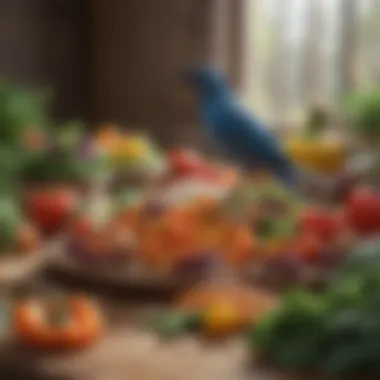
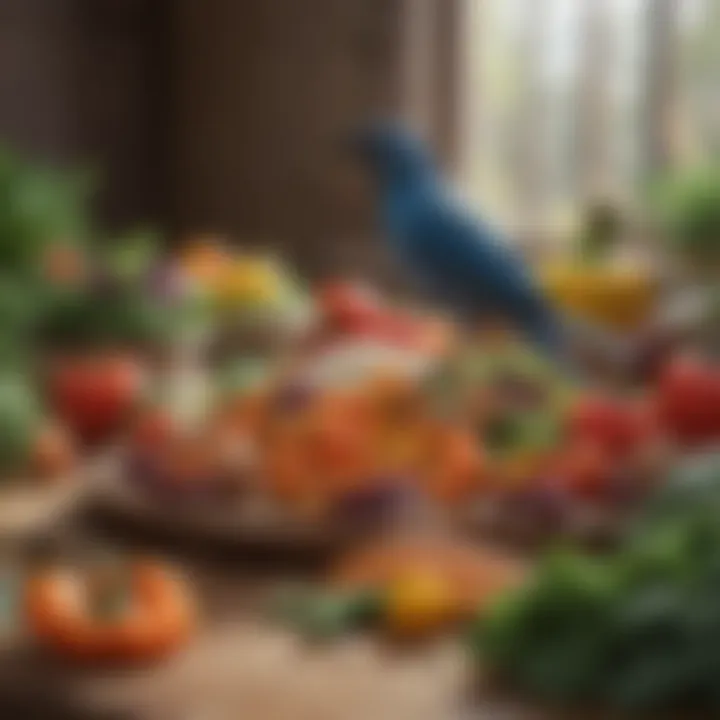
Intro
Creating nutritious meals for pet birds can feel overwhelming; however, it doesn't have to be a daunting task. The BirdTricks Chop Recipe provides a streamlined approach to proper avian nutrition, ensuring that feathered friends receive all the essential vitamins and minerals. In addition to the recipe itself, it’s also important to understand how to care for, feed, and engage with these lively companions.
Care Tips
Caring for birds involves much more than just feeding them. It’s a daily commitment that requires understanding their needs in various aspects.
Daily Care Routines
Every day, birds thrive on routine. This includes feeding at the same times, offering fresh water, and spending quality time with them. For instance, serving Chop in the morning can signal the start of the day for your bird. It creates a consistent environment, giving them a sense of security. Additionally, notice how your bird reacts to various daily activities; this can guide you on what they find comforting or stressful.
Cage Setup and Maintenance
A bird’s home should resemble a small, engaging habitat. Make sure the cage is spacious enough for your bird to move around freely. Use perches of various diameters to promote foot health. Regularly check that the cage is clean; any signs of droppings or leftovers can lead to harmful bacteria growth. A good practice is to do a full clean at least once a week, while spot cleaning should occur daily.
Hygiene and Cleaning Practices
It’s essential to keep the bird’s environment crisp and tidy. Use natural, non-toxic cleaners to wipe down surfaces. When feeding Chop, always use clean dishes. Birds can be sensitive to smells and residues, so ensure everything they touch is free from chemicals or harsh odors.
Seasonal Care Adjustments
As the seasons change, so do the needs of your avian companion. During the winter, ensure they are not exposed to cold drafts. In summer, provide fresh, cool water more frequently to prevent overheating. Adjusting their care routine seasonally can make a significant difference in their comfort and health.
Behavioral Insights
Understanding your bird's behavior can vastly improve the bond you share. Being attentive to their body language can provide insight into their mood and needs.
Understanding Bird Body Language
Birds communicate much through their body language. A relaxed bird will fluff its feathers or perch calmly. Conversely, if the bird ruffles its feathers and remains still, it may be feeling threatened. Noting these signals can help you adapt your interaction accordingly.
Common Behavioral Issues and Solutions
Some birds may experience problems such as feather plucking or excessive screeching. Identifying the root cause is crucial; it might be boredom or a lack of attention. Providing ample toys and interaction time can alleviate some of these issues.
Positive Reinforcement Techniques
Using positive reinforcement is effective in training birds. Rewarding them with treats or praise when they perform desired behaviors encourages them to repeat these actions. This builds trust between you and your pet.
Social Interaction Needs
Birds are inherently social creatures. Many species thrive on interaction with their human companions and require it for emotional health. Plan regular playtime outside of the cage and engage them in conversation to foster this connection, ensuring that they feel valued and included.
Nutrition Guides
Bird diet is crucial to long-term health. Understanding what to include in their meals is step number one.
Essential Diet Components
A balanced diet for birds typically includes a mix of seeds, vegetables, and fruits. The Chop recipe incorporates all these elements, making it a well-rounded choice. Remember, variety is key!
Safe and Toxic Foods
It's equally important to be aware of what foods are harmful. Avocados, chocolate, and caffeine are off-limits for birds. Always research before introducing new foods to their diet.
Supplements and Treats
Occasional supplements can benefit your bird, especially if they are on a specialized diet. Look for high-quality products specifically made for birds. Treats should be offered sparingly to avoid obesity.
Feeding Strategies for Different Species
Different bird species have varying needs. For instance, a parrot's dietary requirements differ considerably from those of a canary. Researching your specific bird’s nutritional demands can help ensure you are meeting their needs effectively.
Wellness and Health
Keeping your bird healthy goes beyond diet. Regular check-ups and attention to their well-being is just as important.
Routine Health Checkups
A visit to the avian vet at least once a year is recommended. During these check-ups, assess your bird's weight, feathers, and overall condition to establish a health baseline.
Identifying Symptoms of Illness
Watch for changes in behavior or appearance. Loss of appetite, fluffing up, or unusual droppings can indicate health issues. Taking swift action is crucial in preventing more serious problems.
Preventative Care and Vaccinations
Vaccinations can play a key role in keeping birds healthy. There’s no harm in consulting your vet on potential vaccines suitable for your bird’s species, especially if they are exposed to other birds frequently.
Mental and Emotional Well-being
Birds thrive on mental stimulation. Engage them with toys, puzzles, or even simple interactive training sessions to keep their minds active. A mentally stimulated bird is often a happier one.
Enriching Activities
Understanding the need for play is essential to the overall well-being of your avian friend.
Toys and Playtime Ideas
Provide a range of toys, from puzzles to swings, to cater for your bird’s preference. Rotate them regularly to keep their interest piqued.
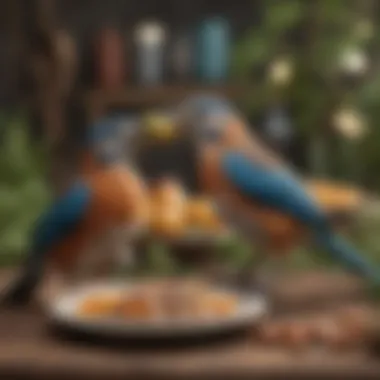
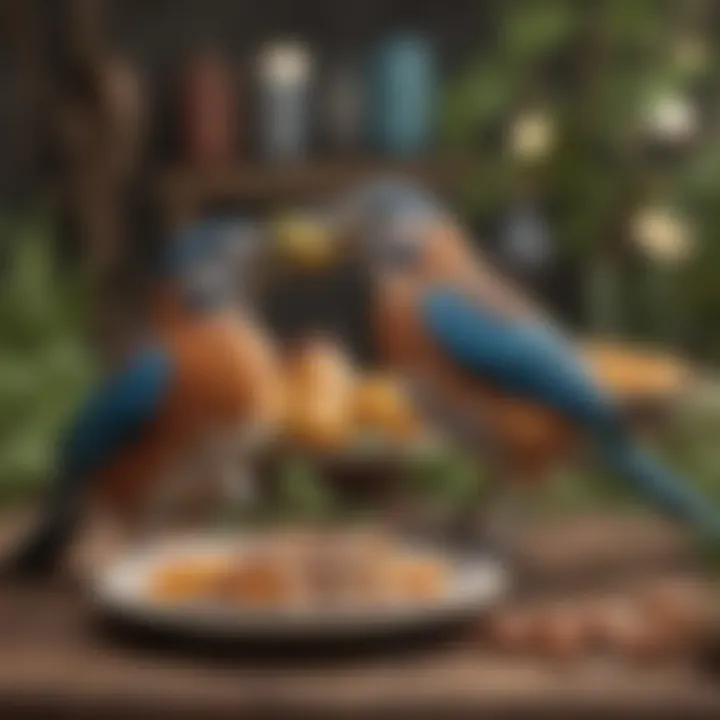
Training and Tricks
Simple tricks can provide physical and mental exercise. Start with basic commands, like “step up” or “turn around”, and give plenty of praise during these sessions.
Outdoor Activities and Interaction
When the weather permits, outside time can be refreshing for birds. Secure harnesses are beneficial for those who want to explore the backyard safely.
DIY Projects for Mental Stimulation
Consider creating your own toys or puzzles from safe household items. This not only saves money but also gives your bird something unique to engage with.
"Nurturing a bird’s health and happiness is a rewarding and fulfilling experience, enhancing the bond between pet and owner."
By following the guidelines outlined above, you can create an environment that is conducive to thriving avian health and happiness. Each step, from feeding to playtime, plays a part in your bird’s overall contentment. Embrace this journey, for it not only improves your bird’s quality of life but enriches your own as well.
Understanding Bird Nutrition
Feeding birds isn’t just tossing seeds into a bowl. It’s an art and a science that lays the groundwork for their well-being and longevity. Proper understanding of bird nutrition helps owners serve meals that nurture both health and happiness, tying together a well-rounded relationship with their feathered friends. The more one knows about the specific needs of birds, the better equipped they'll be to provide a diet that supports their vibrant lives.
Essential Nutrients for Birds
Vitamins
Vitamins are like the fine spices in a well-cooked meal; they contribute essential benefits that enhance the overall health of birds. Birds need a mix of both fat-soluble and water-soluble vitamins to thrive. For example, Vitamin A plays a vital role in maintaining good vision and a healthy immune system, and can be found in foods like carrots and leafy greens.
The thing that sets vitamins apart in bird diets is their micronutrient function. They actively support metabolism and cellular processes but require careful balance—too much of a good thing can lead to toxicity or deficiencies. A diverse diet using fresh ingredients ensures that they receive a variety of these important vitamins.
Minerals
Minerals, on the other hand, are the hard hats of bird nutrition, providing strong structure and function to avian bodies. Calcium is particularly crucial, especially for breeding females and species such as parrots. It plays a significant role in bone health and egg production.
Unique to minerals is that they aid in muscle function and nerve transmission. We can’t overlook the necessity of providing minerals like iron, zinc, and magnesium through a diet rich in seeds, greens, and even some fortified pellet options. However, care should be taken as excessive mineral intake can cause kidney problems or other health issues.
Proteins
Proteins are the powerhouses, building blocks for growth and repair in birds. When it comes to avian meals, proteins supply the amino acids that are crucial for muscle development, feather growth, and overall vitality. These can be sourced from a variety of options, including legumes, nuts, and lean meats.
What makes proteins a worthy addition is that they not only promote health but also support energy levels. Birds require protein especially during molting and breeding seasons, but be cautious; too much protein can lead to issues such as fatty liver disease.
Fats
Fat provides concentrated energy and is an oft-misunderstood component in bird diets. Essential fatty acids, like Omega-3 and Omega-6, help support skin and feather health, and can improve overall vitality. Sources include nuts and certain seeds like flaxseeds.
The key highlight of fats is their energy density; they pack a nutritional punch in small amounts. However, a diet loaded with fats can lead to obesity and related health complications, so moderation is crucial.
Importance of a Balanced Diet
Impact on Health
A balanced diet is paramount. It directly influences a bird’s immune system, energy levels, and overall health. When avian diets are thoughtfully constructed with varied nutrients, birds tend to display fewer health issues and enjoy a high-quality life. Owners often find that vibrant, fresh food contributes to their birds’ physical condition and liveliness.
The unique feature of a balanced diet lies in its holistic approach; it educates owners that avian health is not just about a single food type. Diversity in meals promotes better internal function and resilience against diseases.
Behavioral Correlation
Birds are not just creatures of instinct; they respond to their diets on multiple levels. What they eat can affect their moods and behaviors. Various studies indicate that a rich nutritional intake can foster playful, social, and active behaviors. When a bird thrives nutritionally, they often engage more with their environments, and their owners notice a noticeable uptick in social interactions.
This interaction with their surroundings showcases the reality that nutrition contributes directly to behavioral outcomes. It implies a nuanced understanding that one’s food choices can enhance, or hinder, their feathered companions’ happiness.
Longevity
Birds can live for many years, but just like humans, their longevity is tied to their diet. Well-fed birds with balanced nutrition not only enjoy more vibrant lives but often have better overall health as they age. Studies have indicated that specific diets can lead to longer life spans, but this is often contingent on including a broad spectrum of nutrients over time.
Essentially, this should encourage any bird owner to invest the time and effort to ensure their pets receive the best nutritional foundation possible. The commitment to proper feeding practices becomes an investment in their future, allowing for shared years of companionship.
A well-rounded diet goes beyond the plate and serves as a foundation for a happy, thriving bird.
The Concept of Chop
The concept of chop is pivotal when it comes to offering a well-balanced diet to pet birds, as it captures not just the nutrients they need, but also presents them in a way that appeals to their natural behaviors. By blending various ingredients into one meal, we simplify the feeding process for bird owners while catering to a bird's dietary requirements. Understanding chop elevates not only your bird's health but also enriches the bond between owner and pet.
What is Chop?
Chop refers to a method of preparing bird food that involves finely chopping or shredding various ingredients, including fruits, vegetables, grains, and proteins. The essence of chop lies in its versatility; it's about combining diverse food items into one dish that ensures your feathered friend gets a smorgasbord of nutrients. Instead of offering a single food source, which can be limiting, chop allows for multiple options in one meal, promoting adventurous eating habits among birds.
Chop can be served fresh or cooked and can vary significantly based on the species, preferences, and nutritional needs of the bird. It’s like a buffet on a plate, tailored specifically for avian appetites.
Benefits of Feeding Chop
Convenience
Convenience is paramount in the world of bird care, and chop embodies this characteristic beautifully. The convenience of chop lies in its preparation and serving style. Preparing a large batch ahead of time means less daily hassle. You can whip up a mix of colorful ingredients, store them, and serve. All you have to do is scoop out a portion when it’s mealtime, making it seamless for busy bird owners.
The unique feature of convenience comes from its bulk preparation, which not only saves time but enables proper storage for later use. A well-prepared chop can stay fresh in the refrigerator for days or even be frozen for longer storage. This aspect makes it a favored choice among dedicated bird owners looking to implement routine without the daily grind.
Nutritional Variety
Nutritional variety stands out as a crucial component of a healthy diet for birds. With chop, the inclusion of an array of ingredients allows for a spectrum of vitamins, minerals, and other essential nutrients all in one dish. This array is designed to mimic a more natural feeding pattern that fosters well-rounded health.
Each ingredient brings its unique set of nutrients to the table; for instance, leafy greens offer fiber, while fruits might contribute vitamins A and C. The unique feature here is the guarantee that birds receive a diverse array of nutrients, which isn't achievable through traditional seed-based diets. Nutritional variety not just enhances health but can also improve behavior and mental stimulation, major indicators that all's well in the avian world.
Waste Reduction


Waste reduction is another fundamental benefit that chop provides. By preparing chop, owners can minimize the leftovers that often accompany traditional feeding methods. Fussy eaters might pick at seeds but leave nutritious pieces behind. Chop ensures that everything in the bowl is consumed because it’s blended and presented as a cohesive dish, reducing food waste.
The unique aspect of waste reduction enhances the overall efficiency of meal preparation. Not only are owners feeding less but also promoting healthier eating habits in their birds by encouraging the consumption of everything offered. Plus, it means less mess, allowing for a cleaner cage environment and less food needing to be thrown away, which is a win-win.
"Chop revolutionizes how we approach bird feeding. It's about making nutrition accessible while keeping our feathered friends satisfied."
In summary, understanding the concept of chop and its benefits lays the foundation for a more effective, compassionate approach to avian nutrition. As we proceed through this guide, the practical aspects of making chop will further empower bird owners to nurture their companions in every bite.
The BirdTricks Chop Recipe Explained
Aiming to provide our feathered friends with a nutritious meal is a consideration that every bird owner should ponder. The BirdTricks Chop Recipe stands out as a solution that is both versatile and nutrient-rich. This recipe not only simplifies meal prep but also promotes the overall health of birds by incorporating diverse ingredients tailored to different species. Understanding this recipe is paving the way toward ensuring that our avian companions flourish.
Core Ingredients Required
When diving into the BirdTricks Chop Recipe, knowing the core ingredients is fundamental. Each category provides essential nutrients that contribute to a bird's well-being and vitality.
Fruits
Fruits bring a splash of color and natural sweetness to the chop. They are chock-full of vitamins and antioxidants that support the immune system. Fruits like apples, bananas, and berries are popular among parrots and are rich in vitamin C. Including fruits is not just about flavor; it enriches the diet with hydration, since many fruits have high water content. Thick-skinned fruits like oranges are crucial for providing calcium and fiber, but care must be taken to avoid seeds that may be toxic to some species.
Vegetables
Vegetables are often the unsung heroes in any chop mix. Green leafy veggies, such as kale and spinach, are powerful sources of vitamins A and K. Moreover, their high fiber content supports digestion, making them a must-have. Crunchy vegetables like carrots or bell peppers add crunchiness and nutrients that keep birds intrigued during mealtime. However, it’s vital to serve vegetables fresh, as cooking can sometimes diminish their nutritional value.
Grains
Grains serve as a base in the BirdTricks Chop Recipe. They supply essential carbohydrates that provide energy, especially for active birds like cockatoos and conures. Options like quinoa and brown rice can offer good protein and energy. Including grains can help the mix achieve better texture, which birds often enjoy. However, portions must be managed, as grains can easily lead to weight gain if fed excessively.
Proteins
Proteins are integral for muscular development and maintaining energy in birds. Incorporating suitable proteins such as cooked chicken, eggs, or lentils can provide necessary amino acids that are critical for growth and health. Some birds particularly enjoy seeds and nuts as protein sources; however, excessive fats from nuts can lead to obesity. Thus, balance is key when selecting protein sources for the chop mix.
Preparation Techniques
The way chop is prepared is just as important as the ingredients selected. Various techniques come into play, ensuring a well-balanced and palatable meal.
Chopping Methods
How finely ingredients are chopped can dramatically change a bird's willingness to eat. Some birds prefer smaller bites, while others may like more substantial pieces. Chopping fruits and vegetables to about the size of a dime ensures they are easy to pick up and reduces waste. Utilizing food processors can offer an even blend, making it easier for birds to consume. Still, one must remember that over-processing can lead to a loss of texture, which some birds might avoid.
Mixing Ratios
Finding the right mixing ratio is a cornerstone in creating a satisfying bird meal. A good rule of thumb would be equal parts of fruits, vegetables, grains, and proteins, then adjusting based on the specific bird species’ preferences. For instance, budgies may prefer a fruit-heavy diet, while larger birds tend to thrive with a more balanced mix. One must pay attention to their bird's enjoyment and health when determining the exact proportions.
Serving Suggestions
When it comes to serving, variety matters. Offer chop in different containers—some birds may prefer picking from a bowl, while others might enjoy foraging. Introducing new flavors weekly can keep birds engaged and excited. Also, it’s wise to avoid serving chop directly from the fridge; letting it rest for a bit at room temperature can enhance its aroma, piquing the interest of your feathered friend.
Remember, a well-rounded diet not only promotes health but also complements the bird-owner bond.
By understanding how to prepare and serve the BirdTricks Chop effectively, we can ensure our avian companions thrive while exploring new tastes and textures.
Ingredient Variations for Different Species
When it comes to feeding our feathered friends, one size does not fit all. Ingredient variations can be crucial for meeting the dietary needs of different species of birds. Each species has its own set of preferences and nutritional requirements, which makes understanding these variations essential. Customizing chop ingredients ensures not only a more enjoyable meal for the birds but also enhances their health and well-being. Moreover, it shows owners are considerate of the unique needs of their pets, fostering a stronger bond and trust.
For Parrots
Specific Food Preferences
Parrots are known for their vibrant personalities and varied diets. These birds often favor fruits and vegetables that align with their natural habitat. For instance, a love for orange slices or leafy greens reflects their instinctual preferences. This aspect of specific food preferences can be instrumental in creating a meal they relish. Not only do these choices often lead to happy and engaged parrots, they also provide essential nutrients. However, it's crucial to mix things up—parrots can get bored just like people. Thus, embracing specific food preferences can keep meals interesting, ensuring consistent nutrient intake.
Avoiding Toxic Ingredients
In the world of avian care, knowledge is power, especially when it comes to avoiding toxic ingredients. Certain foods, like avocado and chocolate, can be downright dangerous for parrots. Recognizing these hazardous options is a key component of responsible bird care. It's beneficial not only to keep these ingredients out of their meals but also to inform others about potential dangers. The unique feature of this aspect lies in its preventive nature, safeguarding parrots from potential health issues that may arise from consuming harmful substances. By being diligent in avoiding toxic ingredients, pet owners demonstrate commitment to their birds’ health, leading to a long, happy life together.
For Small Birds
Adjusting Portion Sizes
For small birds, portion sizes require careful consideration. These delicate creatures eat less than larger birds, and overfeeding can lead to obesity or other health problems. Adjusting portion sizes helps owners maintain a healthy diet while preventing waste. Furthermore, smaller birds enjoy frequent, smaller meals—this mimics their natural foraging habits. By paying attention to this aspect, bird owners can create a balanced meal plan that supports their health, while also keeping feeding times engaging.
Using Finely Chopped Ingredients
When it comes to small birds, using finely chopped ingredients is paramount. Their beaks are designed for nibbling, making smaller pieces easier to consume. This not only enhances their feeding experience but also allows them to get the most nutrients out of each meal. Finely chopped meals can also reduce waste, as birds are less likely to discard uneaten larger pieces. By tailoring the size of the food, owners significantly improve the chances that their little friends will enjoy every bite.
For Exotic Birds
Considering Exotic Ingredient Availability
Exotic birds often require special diets, reflecting their vibrant habitats. Considering exotic ingredient availability means looking for specific fruits, vegetables, and grains that are both safe and beneficial. The challenge is in keeping these ingredients fresh and accessible. Owners should explore local markets or specialty stores to find these unique ingredients, ensuring their birds receive a nutritious, diverse diet. This effort not only enriches the birds' meals but also connects owners to their local community, enabling a shared experience.
Nutritional Customization
Nutritional customization involves tailoring the bird's diet to meet individual needs. Different species might have varying levels of fats, protein, or fiber they require. This aspect encourages owners to be attuned to their bird’s specific health needs, which can change over time. Customizing their meals ensures they receive the right nutrients, ultimately supporting their overall well-being. It’s a delicate balance, but one that can lead to a healthier, more thriving bird. By adjusting their diet based on observations, owners demonstrate a high level of care, likely deepening their bond with their exotic companions.
"Feeding birds is about knowing their needs and preferences. It’s a dance that requires attention, commitment, and a willingness to adapt."
Through these ingredient variations tailored for specific species, bird owners can embrace a deeper understanding of the complexities of avian nutrition, ensuring their pets lead healthy, fulfilled lives.
Storing and Serving Chop
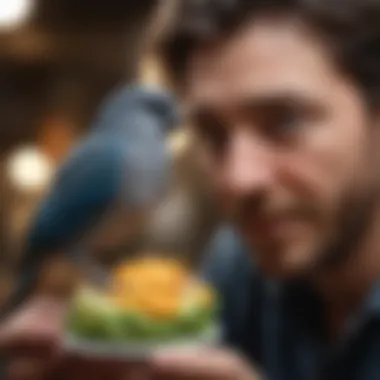
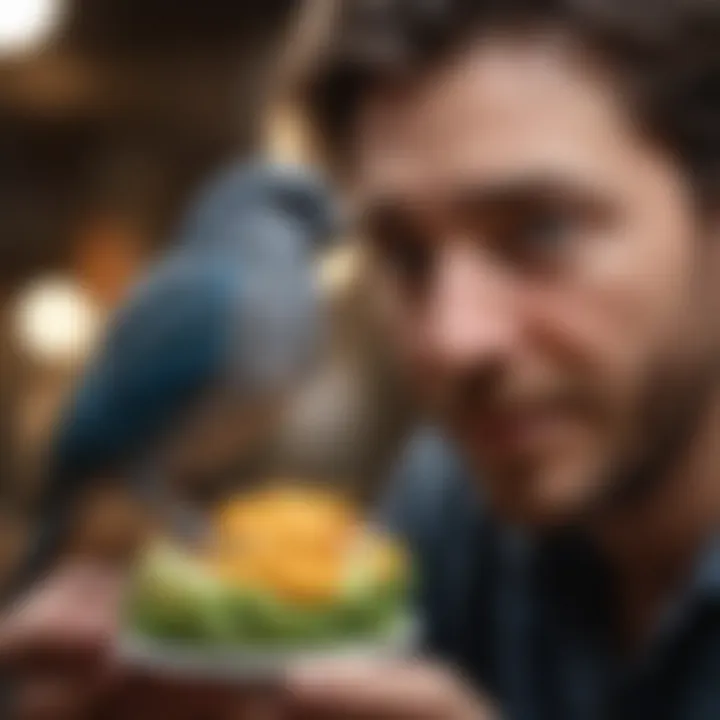
Storing and serving chop properly is critical for the health of your feathered companions. Without the right practices, the nutrients from your carefully prepared chop could get lost, leading to ineffective feeding. Additionally, improper storage can introduce contaminants that might harm your birds. Keeping these practical guidelines in mind ensures your pets get the most out of their meals.
Best Storage Practices
When it comes to storing chop, two methods often take center stage: refrigeration and freezing. Each has its strengths, and understanding these can help bird owners maintain the nutritional quality of their avian meals.
Refrigeration Tips
Refrigeration is perhaps the most straightforward approach to keep chopped meals fresh. Storing chop in the fridge helps preserve the moisture content and nutritional value over a significant period. It is essential to keep the chop air-tight in a container, preferably glass or high-quality plastic, to minimize exposure to air and moisture. A key characteristic of refrigerating chop is its accessibility; it allows you to quickly serve fresh meals daily.
However, there is a notable disadvantage: fresh chop has a limited shelf life, typically lasting about three to five days in the refrigerator. As with many food storage scenarios, proper monitoring is key here. You should always check for any signs of spoilage, such as a sour smell or off-colors, before serving it to your birds.
Freezing Methods
On the other end of the spectrum is freezing, which can greatly extend the longevity of chop. This method not only retains the nutritional value but also allows for batch preparations. Preparing large quantities at once can save time for bird owners who may have busy schedules. Simply divide the chop into meal-sized portions, placing them into freezer-safe bags or containers, and store them accordingly.
The primary advantage of this method is the long-term preservation; chop can typically last up to six months in the freezer. However, a unique feature you might want to consider is that once thawed, the consistency of the vegetables might change, and they may appear more mushy compared to their fresh state. Birds accustomed to crunchy textures might be put off by this.
Serving Guidelines
Once you've got your chop stored correctly, it’s essential to serve it right. Proper serving not only maximizes the nutritional benefits but also keeps your birds happy and healthy.
Portion Control
Portion control is fundamental to avian health, just like it is for human diets. Setting the right amount of chop to serve at each meal helps prevent waste and ensures that your birds are getting the right balance of nutrients. It's best to consider the size and species of your bird when determining how much to serve. A large parrot will require substantially more than a small finch.
An effective approach is to start with smaller portions, observe how much your bird consumes, and adjust accordingly over time. This ensures that your bird is neither overfed nor underfed. Not to forget, leaving too much food can lead to spoilage, which brings us back to the storing practices.
Serving Frequency
Establishing a feeding routine also contributes significantly to your bird's overall health. Serving chop two to three times daily can help maintain your pet’s energy levels and encourage regular eating habits. The critical aspect of this practice is consistency; birds thrive on routine, and knowing when to expect food can bring a sense of security.
Too many serving adjustments can confuse your pet, potentially making them reluctant to eat. Hence, find a serving frequency that suits your bird and stick with it to promote a healthy feeding habit over time.
Good storage and serving practices go a long way in ensuring your bird enjoys its meals while staying healthy. Remember, a happy bird means a happy owner!
Monitoring Bird Health and Adaptation
In the journey of nurturing our feathered companions, keeping a keen eye on their health and adaptability is crucial. Monitoring bird health isn't merely a periodic check; it's a continuous process that ensures our birds thrive on the BirdTricks Chop Recipe. By remaining observant, bird owners can spot the details that matter, whether it’s from their eating habits to how they engage with their environment. A vigilant approach not only supports our pets' immediate well-being but fosters long-term health, making it a fundamental aspect of avian care.
Signs of Healthy Eating
The signs that indicate a bird is eating healthily are numerous. Two critical metrics that stand out are active behavior and feather quality.
Active Behavior
Birds that are active display a sense of well-being. There's something gratifying about witnessing their vigor—those spontaneous flights around the room, or that playful bobbing from perch to perch. Active behavior is a hallmark of a bird’s happiness, directly contributing to its overall health. It's not just a fun characteristic; it's a beneficial indicator. When birds are lively, their hearts are pumping, and their bodies are engaged, which highlights a balanced diet with proper sustenance.
Uniquely, active birds also tend to exhibit creativity in their environment. They might explore different toys or interact with their human companions. This exploratory behavior is advantageous as it promotes both mental stimulation and physical exercise. However, if a bird transitions from being lively to lethargic, it would be wise to reconsider their diet and ensure it aligns with the nutritious needs stipulated for their species.
Feather Quality
Feathers can tell tales—tales of a bird's health and nutritional status. Healthy birds possess feathers that are vibrant, smooth, and well-aligned. The key characteristic of feather quality lies in its appearance. Feathers should typically show a glossy sheen; if they appear dull or frayed, that’s a red flag. Feather quality is another significant essence in this article, as it showcases how efficiently a bird absorbs and processes nutrients from foods.
Moreover, the unique feature of feather quality is its correlation with the bird's overall condition. Well-nourished birds tend to have outstanding feather quality, while poor dietary choices can lead to a complete feather disaster. This relationship underscores the essence of maintaining a nutritious diet like the BirdTricks Chop Recipe. Observing feather quality, therefore, isn't just cosmetic—it's a matter of health, indicating nutrition sufficiency.
Identifying Issues
Even with the best of care, sometimes things may just not be right. Recognizing signs of potential problems can be a life saver. Two areas demanding attention are weight changes and digestive problems.
Weight Changes
Birds can be particularly sensitive to their diets, leading to noticeable weight changes over time. Unexpected weight gain or loss can impact their overall well-being and is often a clear signal to take action. Weight changes give insights into a bird's eating habits, ensuring that the right balance is maintained. The key characteristic of weight changes is its visibility; a pet owner can easily observe changes when handling or watching their bird interact in its usual spaces.
What sets weight changes apart is the immediacy of its feedback. If a bird is gaining weight, it could indicate overfeeding or lack of activity, whereas significant weight loss may signal poor diet or potential health issues. Having a diet plan like the BirdTricks Chop Recipe can mitigate many of these challenges, but if changes become exaggerated, a consultation with an avian vet is wise.
Digestive Problems
Digestive issues are no joke when it comes to bird health. A bird’s digestion encapsulates a wide range of matters from how well it tolerates certain foods to its overall digestive comfort. Digestive problems manifest through various signs such as droppings that don’t look right or changes in appetite. The key characteristic of digestive problems is their direct relation to diet—what goes in must come out, and how that process fairs can tell you a lot.
A unique aspect of digestive issues is they can occur suddenly, possibly due to a new ingredient introduced in their diet. This makes monitoring particularly important. Consequently, adopting a well-structured feeding routine with the BirdTricks Chop Recipe can help pinpoint which ingredients suit your bird best, minimizing the chances of gut-related troubles. Being proactive pays off—catching digestive problems early allows for timely intervention, promoting overall wellness.
When bird owners observe these signs and issues, it fosters not only a healthier pet but deepens the bond with their avian friends. Taking the initiative to monitor health closely leads to a more enriching experience for both bird and owner.
Epilogue
In wrapping up our exploration of the BirdTricks Chop Recipe, it’s clear that ensuring proper nutrition for our feathered companions is both a science and an art. The critical aspect of a balanced diet cannot be overstated. When bird owners prioritize nutritious meals, they lay the groundwork for healthier, more vibrant lives for their pets. This article dissected various elements resulting in a comprehensive approach to avian diets.
Reinforcing Healthy Habits
Fostering healthy habits in our birds goes beyond just the food we serve. Birds, much like us, acquire preferences and behaviors that stem from their early exposure. The Chop Recipe encourages repetition and consistency, which can be paramount in ensuring that our birds accept new foods without fuss.
Let’s break it down further:
- Routine Feeding: Establishing a schedule helps birds understand when to expect their meals, naturally making them more enthusiastic eaters.
- Experimentation with Textures: Introducing variety in textures—from crunchy veggies to smooth fruits—can stimulate their interest in diverse foods.
- Observation and Adjustment: Regularly watching how birds respond to different ingredients can provide invaluable insights into their likes and dislikes, making it easier to tailor meals to their preferences.
By making these small adjustments and consistently offering nutritious Chop, bird owners help their pets develop optimal eating habits and preferences that support their overall health.
Final Thoughts on Avian Nutrition
When it comes to avian nutrition, it's not just what’s on the plate—it’s the whole package. The relationship between diet, behavior, and longevity is complex and interconnected. As we’ve discussed, each ingredient in the Chop Recipe plays a critical role, contributing not only to the health of birds but to the bond between the owner and pet.
Many bird owners may find themselves overwhelmed by the recommendations, often wondering what is best. The key takeaway here is to embrace the journey. Learning about your bird’s nutritional needs can lead to fulfilling experiences beyond just meal prep.
"Nourishing our birds is about evolution, not perfection.”
Incorporating gradual changes and being patient leads to remarkable outcomes. Thus, always remain mindful of your bird’s unique dietary requirements—what works for one might not suit another. Share your experiences with other owners on platforms such as Reddit or Facebook; you’d be surprised how many will have valuable tips.
As we conclude, remember that a healthy bird is a happy bird, and through proper nutrition, you can pave the way for joyous flights and strong bonds with your avian friends.















